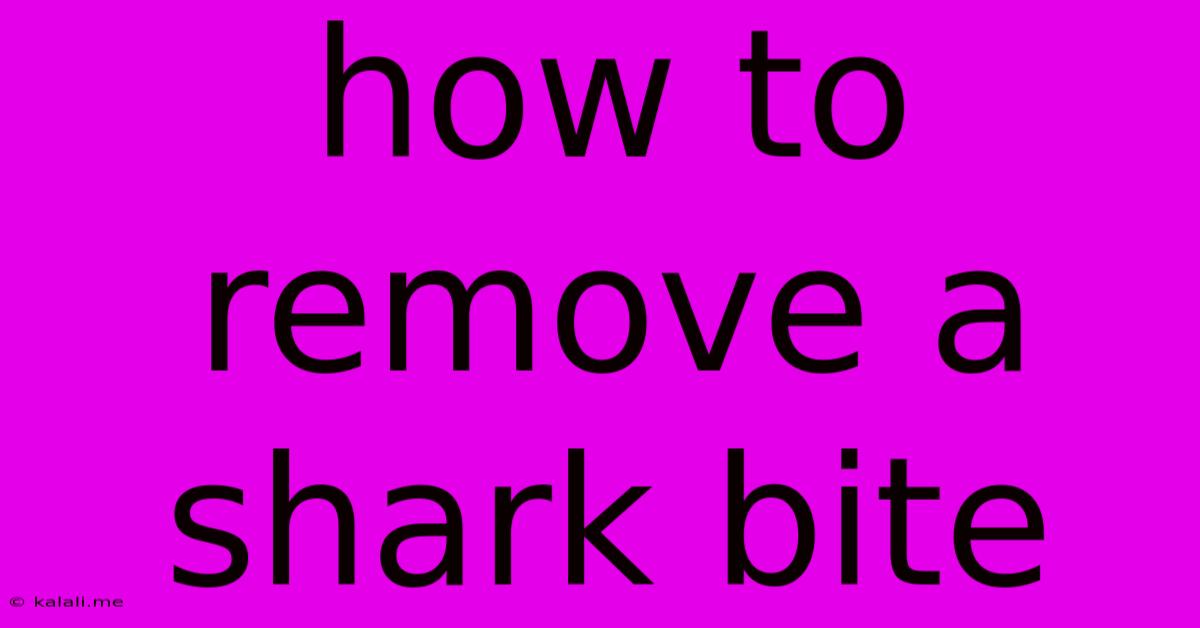How To Remove A Shark Bite
Kalali
May 31, 2025 · 3 min read

Table of Contents
How to Treat a Shark Bite: A Comprehensive Guide
Meta Description: Shark bites are rare but incredibly serious injuries requiring immediate medical attention. This guide details the steps to take after a shark attack, focusing on first aid and seeking professional help. Learn about preventing infection and ensuring the best possible recovery.
Shark attacks, while terrifying and dramatic, are thankfully rare events. However, understanding how to respond to a shark bite is crucial for survival and minimizing long-term damage. This article provides a comprehensive guide on treating a shark bite, focusing on immediate first aid and subsequent medical care. Remember, this information is for educational purposes only and does not replace professional medical advice. Seek immediate medical attention after any shark bite.
Immediate Actions After a Shark Attack
The priority after a shark bite is to escape the immediate danger and initiate first aid.
-
Get out of the water: Safely exit the water, assisting the victim if necessary. Avoid further injury by calmly and quickly moving to safety.
-
Control bleeding: Apply direct pressure to the wound using a clean cloth or dressing. Elevating the injured limb above the heart can also help reduce bleeding. Do not apply a tourniquet unless absolutely necessary and only if trained to do so. Improper use can lead to further complications.
-
Clean the wound: Gently clean the wound with clean water, removing any visible debris. Avoid scrubbing, as this can cause further damage.
-
Prevent infection: Cover the wound with a clean, sterile dressing to minimize the risk of infection. Shark bites are prone to infection due to the bacteria present in seawater and the shark's mouth.
-
Seek immediate medical attention: Transport the victim to the nearest medical facility as quickly as possible. Shark bites require specialized medical care, including cleaning, debridement (removal of damaged tissue), and potentially surgery. The risk of infection, significant blood loss, and nerve damage necessitates professional intervention.
Medical Treatment for Shark Bites
Medical professionals will perform a thorough assessment of the injury, including:
- Wound cleaning and debridement: Removing damaged tissue, debris, and bacteria is crucial to prevent infection. This often involves surgical procedures.
- Wound closure: Depending on the severity and location of the wound, stitches or other closure techniques may be used. Some wounds may need to be left open to heal naturally.
- Antibiotics: Antibiotics are usually prescribed to prevent and treat infection.
- Pain management: Pain medication will be provided to manage the discomfort associated with the injury.
- Tetanus shot: A tetanus booster shot is essential to prevent tetanus infection.
- Imaging: X-rays or other imaging techniques may be used to assess the extent of the injury and check for any broken bones.
Long-Term Care and Recovery
Recovery from a shark bite can take several weeks or months, depending on the severity of the injury. Ongoing care includes:
- Wound care: Regular cleaning and dressing changes are essential to promote healing and prevent infection.
- Physical therapy: Physical therapy may be necessary to restore function and range of motion in the affected limb.
- Scar management: Scar tissue can form, and scar management techniques may be recommended to minimize scarring.
- Psychological support: The psychological impact of a shark attack should not be underestimated. Seeking professional help is advisable to address any emotional distress.
Preventing Shark Bites
While the chances are slim, understanding and implementing preventative measures can reduce your risk of a shark encounter:
- Avoid swimming at dawn and dusk: These are peak feeding times for many shark species.
- Avoid murky water: Sharks rely on sight and can be more prone to accidental bites in low visibility.
- Don't swim alone: Having others around increases the chances of getting help in an emergency.
- Avoid wearing shiny jewelry: Shiny objects can attract sharks.
- Be aware of your surroundings: Pay attention to your environment and be cautious of any unusual activity.
Remember, the key to successfully managing a shark bite is immediate action and professional medical care. This article serves as a guide, but consulting a medical professional is crucial for the best possible outcome.
Latest Posts
Latest Posts
-
How Do You Say What The Hell In Spanish
Jun 01, 2025
-
Is Standard Deviation Or Beta Best For Stand Alone Risk
Jun 01, 2025
-
Does Baking Soda Put Out Fires
Jun 01, 2025
-
What Happens If You Rob A Black Market Dishonored 2
Jun 01, 2025
-
Why Did I Think Puce Was Green
Jun 01, 2025
Related Post
Thank you for visiting our website which covers about How To Remove A Shark Bite . We hope the information provided has been useful to you. Feel free to contact us if you have any questions or need further assistance. See you next time and don't miss to bookmark.